As an exercise therapist I raise awareness. I cannot count the number of clients that I treat who need to be educated on correct sleeping positions and how their sleeping position in turn affects poor biomechanics and causes pain throughout their given day.
This common issue repeatedly arises in discussion as clients are unaware of how their sleeping position has a direct impact on the way they move during their personal training sessions. A light bulb moment occurs every time when I explain how incorrect sleeping patterns impact our mobility, flexibility, and myofascial spiral patterns of the body and why they are in pain. As a result this may lead to shoulder pain, lower back, hip and groin discomfort and even acute wry neck or neck stiffness.
There are four (4) common sleeping positions that you may be subject to including:
- Side laying arm under pillow position
This common position is for the side laying person who likes to snuggle up by tucking one arm under their pillow. When their shoulder is in flexion and externally rotated the posterior capsule is continually under load from the weight of the head, neck and pillow. Unnecessary activation of the anterior deltoid and biceps also takes place, along with poor circulation to the shoulder capsule, restricting nerve blood flow in this side laying closed-in position and leading to rotator cuff impingement.

- Prone stomach sleep pillow snug position – Most Dangerous
This poor sleeping position creates two unnecessary patterns affecting the shoulder and groin. From the image you can discover the spiral pattern occurring where the leg is in the number four position to leverage the opposite arm tucking under the pillow when in shoulder flexion and internal rotation (image shows same leg and shoulder for a better view of both joints).
This is the most dangerous sleeping position because the lateral deltoid of the shoulder capsule is under its greatest load with the shoulder in flexion and external rotation, particularly when the body is in sleep mode. This may also lead to a weakened over stretched groin as it remains in external rotation comparatively to the straightened leg throughout the night. This sleeping position will negatively impact the way you start your day in this myofascial twisted position.

- Back laying soccer pass
When sleeping on your back you may find yourself comfortable with one leg in external rotation at the hip in the open foot position. This acknowledges that the adductors of the groin are weakened comparatively to the straightened leg and perhaps the gluteals are over activated when the leg remains in this hip opener position. The myofascial pattern that this simple position negatively affects could be the opposing abdominal (iliopsoas) and shoulder/neck muscles that attempt to counteract the leg.

- Back laying number 4 position
When laying on your back you may be comfortable with the hip in external rotation and the knee bent in flexion so that the foot tucks under the opposing straightened leg. Similarly to sleeping pattern Pillow Snug 2 you have imposed additional load under the crossed leg with the straightened leg. This adds excess load on the adductors, groin and gluteals of the opposing leg. The adverse effect of this sleeping position is waking up in the morning with poor leg circulation of the cross legged leg.

What is the correct sleeping position?
As we age we move from face down (prone) foetal sleeping positions of our infancy and move into side and back laying positions. This is because the level of discomfort increases as our bowels increase in size with age and place unnecessary abdominal pressure on our diaphragm and breathing.
This is why sleeping on your side and back is the correct position, keeping in mind where you position your upper and lower limbs. It is recommended that you sleep with a pillow beneath your knees when laying on your back to further enhance the natural curvature of your spine and reduce lumbar pressure.
The diagrams below illustrate correct options, remembering where you start may be very different to where you end up on awakening:
1. Corpse

2. Foetal position

The final component to a good night’s sleep is the height of your pillow. It is paramount that the pillow allows your head and neck to remain in a neutral position with an alignment throughout the trunk of the body. This is to reduce the amount of lateral flexion and extension of the neck.

If you currently have shoulder rotator cuff impingement you may choose to sleep in the side laying position with a pillow beneath the armpit to ensure that the scapula (shoulder blade) remains in position and reduces the amount of unnecessary load on the four muscles that collectively make-up the rotator cuff namely; infraspinatus, supraspinatus, teres minor, and subscapularis (SITS).
If on the other hand you are experiencing hip and/or groin pain then you may choose to sleep with a pillow beneath your thighs in side laying to allow your hip to remain aligned during your sleep and reduce the amount of load on the outer thigh and hip.

Photography by – Adam Holding


LEAVE A COMMENT